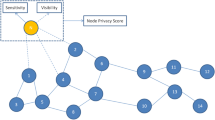Abstract
There is no doubt that social websites have become one of the greatest inventions of the twenty-first century. Maintaining social connections, getting new and new friends, online entertainment: these are the very things we expect a good portal to provide. The concept of the social websites is that upon registration users share a desired amount of personal data with other users and after that they build a so called friend network using their acquaintances as building elements. The more acquaintances are present the more information is accessible during a certain period of time.
Access this chapter
Tax calculation will be finalised at checkout
Purchases are for personal use only
Similar content being viewed by others
References
Sik Lányi C. “Multimedia Software Interface Design for Special Needs Users”, Encyclopedia of information science and technology, 2nd Edition, IGI Global, 2008
WHO: “Situation Analysis for Health at Work and Development of the Global Working Life” from: http://www.who.int/occupational_health/publications/globstrategy/en/index4.html
EU Commission: “2010: A Europe Accessible for All”, Report from the Group of Experts set up by the European Commission, from: http://europa.eu.int/comm/employment_social/index/final_report_ega_en.pdf
EC Europa: “Ageing Well in the Information Society” from: (http://ec.europa.eu/information_society/newsroom/cf/itemdetail.cfm?item_id=3457
R. Jani, M. Schrepp. “Are the Web Accessibility Guidelines Applicable and Sufficient for Web Applications?” 8th European conference for the advancement of assistive technology in Europe: Assistive technology from virtuality to reality (AAATE 2005), IOS Press, 2005, pp. 499–503
M. Schreep, R. Jani. “Efficient Keyboard Support in Web-Pages”, 8th European conference for the advancement of assistive technology in Europe: Assistive technology from virtuality to reality (AAATE 2005), IOS Press, 2005, pp. 504–508
Wikipedia, “List of Social Networking Websites” from: http://en.wikipedia.org/wiki/List_of_social_networking_websites
W3C Quality Assurance Tools from: http://www.w3.org/QA/Tools/
WebXACT from: http://webxact.watchfire.com/
Opera from: http://www.opera.com/
RDF Validator from: http://www.w3.org/RDF/Validator/
XML Schema Validator from: http://www.w3.org/2001/03/webdata/xsv
C. Sik Lányi, S. Forrai, N. Czank, Á. Hajgató. “On Developing Validator Software XValid for Testing Home Pages of Universal Design”, 12th international human computer interaction conference: universal access in HCI (HCII 2007), LNCS 4554, Springer, 2007, pp. 284–293
C. Sik Lányi, S. Forrai, N. Czank, Á. Hajgató. “Are the WEB Sites Barrier-Free, if they are not, How Many of the Sites are Barrier-free?” 9th European conference for the advancement of assistive technology in Europe: challenges for Assistive Technology, (AAATE 2007), IOS Press, 2007, pp. 627–932
K. Miesenberger, F. Pühretmair. “Help.gv.at – Accessible e-Government in Austria,” 8th European conference for the advancement of assistive technology in Europe: Assistive technology from virtuality to reality (AAATE 2005), IOS Press, 2005, pp. 489–493
VentureBeat from: http://venturebeat.com/2008/12/18/2008-growth-puts-facebook-in-better-position-to-make-money/
M. Zuckerberg, Blog Facebook: “An Open Letter from Facebook Founder Mark Zuckerberg” 2009, from: http://blog.facebook.com/blog.php?post=190423927130
iWiW, “iWiW User Count Passed 4 Million”, from: http://www.penzcentrum.hu/cikk/1015273/1/atlepte_a_4_milliot_az_iwiw_felhasznalok_szama
Mashable, the Social Media Guide, “MySpace, America’s Number One”, from: http://mashable.com/2006/07/11/myspace-americas-number-one/
Wikipedia, MySpace, from: http://en.wikipedia.org/wiki/MySpace
Wikipedia, YouTube, from: http://en.wikipedia.org/wiki/YouTube
YouTube, Help, from: http://www.google.com/support/youtube/bin/answer.py?answer=57788
WCAG 1.0, from: http://www.w3.org/TR/1999/WAI-WEBContent-19990505
WCAG 2.0, from: http://www.w3.org/TR/WCAG20/
C. Sik Lányi, “Testing the Accessiblity of WEB Sites”, In Press in Special Issue Web for All, International Journal of Knowledge and Web Intelligence, Inderscience Publishers, Volume 2, Number 1, January 2011
Acknowledgements
The authors would like to return thanks for the help of Mr. Sándor Forrai, who developed the XValid software as an MSc thesis work at the University of Pannonia.
Author information
Authors and Affiliations
Corresponding author
Editor information
Editors and Affiliations
Rights and permissions
Copyright information
© 2010 Springer Science+Business Media, LLC
About this chapter
Cite this chapter
Lányi, C.S. (2010). Accessibility Testing of Social Websites. In: Furht, B. (eds) Handbook of Social Network Technologies and Applications. Springer, New York, NY. https://doi.org/10.1007/978-1-4419-7142-5_19
Download citation
DOI: https://doi.org/10.1007/978-1-4419-7142-5_19
Published:
Publisher Name: Springer, New York, NY
Print ISBN: 978-1-4419-7141-8
Online ISBN: 978-1-4419-7142-5
eBook Packages: Computer ScienceComputer Science (R0)




